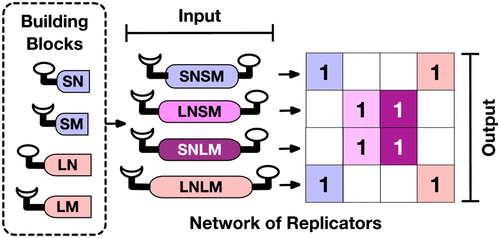当前位置:
X-MOL 学术
›
J. Am. Chem. Soc.
›
论文详情
Our official English website, www.x-mol.net, welcomes your
feedback! (Note: you will need to create a separate account there.)
Generating System-Level Responses from a Network of Simple Synthetic Replicators
Journal of the American Chemical Society ( IF 14.4 ) Pub Date : 2017-11-17 00:00:00 , DOI: 10.1021/jacs.7b09735 Jan W. Sadownik 1 , Tamara Kosikova 1 , Douglas Philp 1
Journal of the American Chemical Society ( IF 14.4 ) Pub Date : 2017-11-17 00:00:00 , DOI: 10.1021/jacs.7b09735 Jan W. Sadownik 1 , Tamara Kosikova 1 , Douglas Philp 1
Affiliation

|
The creation of reaction networks capable of exhibiting responses that are properties of entire systems represents a significant challenge for the chemical sciences. The system-level behavior of a reaction network is linked intrinsically to its topology and the functional connections between its nodes. A simple network of chemical reactions constructed from four reagents, in which each reagent reacts with exactly two others, can exhibit up-regulation of two products even when only a single chemical reaction is addressed catalytically. We implement a system with this topology using two maleimides and two nitrones of different sizes—either short or long and each bearing complementary recognition sites—that react pairwise through 1,3-dipolar cycloaddition reactions to create a network of four length-segregated replicating templates. Comprehensive 1H NMR spectroscopy experiments unravel the network topology, confirming that, in isolation, three out of four templates self-replicate, with the shortest template exhibiting the highest efficiency. The strongest template effects within the network are the mutually cross-catalytic relationships between the two templates of intermediate size. The network topology is such that the addition of different preformed templates as instructions to a mixture of all starting materials elicits system-level behavior. Instruction with a single template up-regulates the formation of two templates in a predictable manner. These results demonstrate that the rules governing system-level behavior can be unraveled through the application of wholly synthetic networks with well-defined chemistries and interactions.
中文翻译:

从简单的合成复制器网络生成系统级响应
能够展现作为整个系统特性的反应的反应网络的创建,对化学科学提出了重大挑战。反应网络的系统级行为本质上与它的拓扑结构和其节点之间的功能连接有关。由四种试剂构成的简单化学反应网络(其中每种试剂正好与两种其他试剂发生反应)即使在催化作用下仅处理一个化学反应时,也可以表现出两种产物的上调。我们使用两个不同大小的马来酰亚胺和两个硝酮(短或长且各自带有互补的识别位点)来实现具有此拓扑的系统,它们通过1,3-偶极环加成反应成对反应,以创建四个长度分隔的复制模板网络。综合的1 H NMR光谱实验揭示了网络拓扑结构,确认孤立地,四个模板中的三个模板是自我复制的,而最短的模板显示出最高的效率。网络中最强的模板效应是两个中等大小的模板之间的相互交叉催化关系。网络拓扑结构使得添加不同的预制模板作为对所有起始材料的混合物的指令会引起系统级的行为。使用单个模板的指令以可预测的方式上调了两个模板的形成。这些结果表明,可以通过应用具有明确化学性质和相互作用的全合成网络来阐明控制系统级行为的规则。
更新日期:2017-11-19
中文翻译:

从简单的合成复制器网络生成系统级响应
能够展现作为整个系统特性的反应的反应网络的创建,对化学科学提出了重大挑战。反应网络的系统级行为本质上与它的拓扑结构和其节点之间的功能连接有关。由四种试剂构成的简单化学反应网络(其中每种试剂正好与两种其他试剂发生反应)即使在催化作用下仅处理一个化学反应时,也可以表现出两种产物的上调。我们使用两个不同大小的马来酰亚胺和两个硝酮(短或长且各自带有互补的识别位点)来实现具有此拓扑的系统,它们通过1,3-偶极环加成反应成对反应,以创建四个长度分隔的复制模板网络。综合的1 H NMR光谱实验揭示了网络拓扑结构,确认孤立地,四个模板中的三个模板是自我复制的,而最短的模板显示出最高的效率。网络中最强的模板效应是两个中等大小的模板之间的相互交叉催化关系。网络拓扑结构使得添加不同的预制模板作为对所有起始材料的混合物的指令会引起系统级的行为。使用单个模板的指令以可预测的方式上调了两个模板的形成。这些结果表明,可以通过应用具有明确化学性质和相互作用的全合成网络来阐明控制系统级行为的规则。











































 京公网安备 11010802027423号
京公网安备 11010802027423号